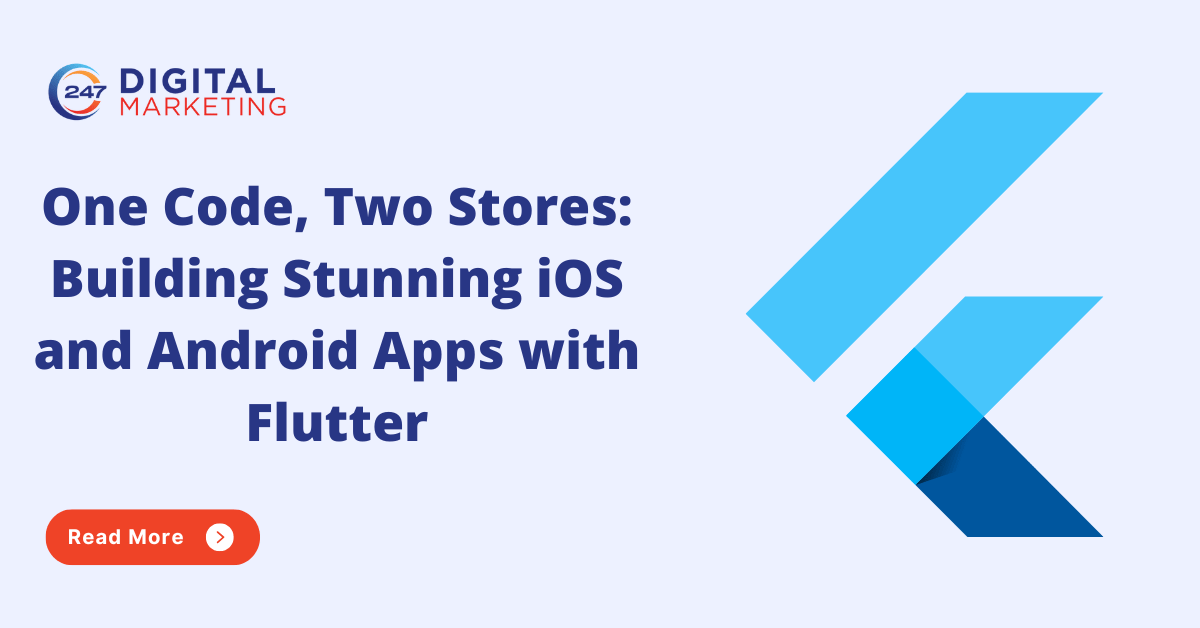One Code, Two Stores: Building Stunning iOS and Android Apps with Flutter

In today’s fast-paced digital world, businesses need mobile apps that deliver exceptional user experiences across multiple platforms. Traditionally, building separate apps for iOS and Android meant double the effort, cost, and time. But what if you could write one codebase and deploy it to two stores, Apple App Store and Google Play, without compromising on performance or design? That’s exactly what Flutter, Google’s open-source UI toolkit, makes possible.
Flutter has revolutionized mobile app development by enabling developers to create beautiful, natively compiled applications for iOS and Android from a single codebase. In this blog, we’ll explore why Flutter is the go-to choice for modern businesses, how it works, and why partnering with the right development company can make all the difference.
Why Flutter? The Power of One Codebase
Flutter’s biggest advantage lies in its ability to eliminate platform-specific development. Instead of maintaining two separate codebases for iOS and Android, developers write one set of code in Dart, Flutter’s programming language, and deploy it across both platforms.
Key Benefits of Flutter:
- Faster Development Cycles
With a single codebase, developers save time and resources. Updates and bug fixes are applied once and reflected across both platforms instantly. - Consistent UI Across Platforms
Flutter uses its own rendering engine, ensuring that your app looks and feels the same on iOS and Android. No more worrying about design inconsistencies. - Hot Reload for Rapid Iteration
Flutter’s “hot reload” feature allows developers to see changes in real-time without restarting the app. This accelerates the development process and improves collaboration. - Native Performance
Unlike hybrid frameworks that rely on web views, Flutter compiles to native ARM code, delivering smooth animations and fast load times.
Building Stunning Apps with Flutter
Creating visually appealing apps is where Flutter truly shines. Its rich set of widgets and customizable components allows developers to craft interfaces that are both functional and aesthetically pleasing.
Material Design and Cupertino Widgets
Flutter supports Material Design for Android and Cupertino widgets for iOS, ensuring platform-specific design guidelines are met while maintaining a unified codebase.
Custom Animations and Themes
Want your app to stand out? Flutter makes it easy to implement custom animations, transitions, and themes that elevate the user experience.
Real-World Use Cases
Many global brands have adopted Flutter for their mobile apps. For example:
- Google Ads uses Flutter for its mobile interface.
- Alibaba leverages Flutter for its e-commerce platform.
- BMW uses Flutter for its My BMW app.
These examples prove that Flutter isn’t just for startups; it’s trusted by enterprise-level organizations for mission-critical applications.
The Business Advantage of Flutter
For businesses, Flutter offers a compelling value proposition:
- Lower Development Costs: One codebase means fewer developers and reduced overhead.
- Faster Time-to-Market: Launch your app on both platforms simultaneously.
- Future-Ready: Flutter supports web and desktop applications, making it a versatile choice for long-term scalability.
Choosing the Right Development Partner
While Flutter simplifies cross-platform development, success depends on expertise. Partnering with a Flutter App Development Company ensures your app is optimized for performance, security, and scalability.
Look for a team that:
- Has proven experience in Flutter projects.
- Understands platform-specific nuances.
- Offers end-to-end services from design to deployment.
If you’re aiming for excellence, consider working with the Custom Mobile App Development Services provider. They’ll help you leverage Flutter’s full potential while aligning the app with your business goals.
Best Practices for Flutter Development
To maximize Flutter’s benefits, follow these best practices:
- Plan for Scalability
Design your architecture to accommodate future features and integrations. - Optimize for Performance
Use Flutter’s profiling tools to monitor and enhance app performance. - Focus on UI/UX
Flutter gives you the tools to make sure your design team uses them to create intuitive, engaging interfaces. - Test Across Devices
Even with a single codebase, thorough testing on multiple devices ensures a seamless experience.
Future of Flutter
Flutter is not just a trend; it’s shaping the future of app development. With Google’s continuous investment and a growing developer community, Flutter is evolving to support:
- Web Applications
- Desktop Apps
- Embedded Devices
This means businesses adopting Flutter today are future-proofing their digital strategy.
Final Thoughts
Building apps for both iOS and Android no longer requires double the effort. With Flutter, you can create stunning, high-performance applications using a single codebase, reducing costs and accelerating time-to-market. Whether you’re a startup or an enterprise, Flutter offers the flexibility and power you need to succeed in a competitive digital landscape.
If you’re ready to take the next step, partner with experts who understand Flutter inside out. The right team can transform your vision into a reality that delights users and drives business growth. Whether you need the iPhone Development Company for iOS excellence or the Android Development Company for Android-specific optimizations, Flutter bridges the gap and delivers both without compromise.
Mitesh Patel is the co-founder of 247 Digital Marketing, LawFirm Marketing and a columnist. He helps companies like Emerson and other top Fortune 500 compnies to grow their revenue.


